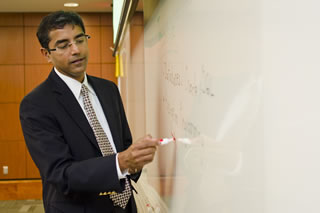News Archive
USF Researchers Show that Television Viewership Data Can Predict National Presidential Election Outcomes

A model built from one show's data could have called eight out of 10 swing states before the 2012 election
TAMPA, Fla. (Oct. 8, 2015) - If an acquaintance tells you he watches "The Daily Show," you might assume a lot about him based on knowing how he spends that 30 minutes in front of the TV.
With data, University of South Florida researchers have more than an assumption to go on. Using TV viewership data from Nielsen, researchers in the USF Muma College of Business built predictive models that potentially could do what so far has been elusive to pollsters and pundits alike: forecast the election outcome in swing states.
The USF researchers published their paper, "Does Television Viewership Predict Presidential Election Outcomes?" in the most recent volume of the journal Big Data, and their findings could hold major implications for the way campaigns are conducted. Among the television programs with the most accurate predictions are two popular shows - A&E's "Duck Dynasty" and Comedy Central's "The Daily Show with Jon Stewart."
Information Systems & Decision Sciences Professor Balaji Padmanabhan, along with USF doctoral student Arash Barfar, built predictive models using data on 547 television programs aired during the four weeks prior to the 2012 election. Their data had nearly a half billion minutes of watch time for nearly 138,000 telecasts.
"The days of surprise about actual election outcomes in the big data world are likely to be fewer in the years ahead, at least to those who have access to such data," said Padmanabhan, who serves as Anderson Professor of Global Management and Chair of the Information Systems Decision Sciences Department.
They divided data by two measures: first, minutes per voter, looking at how many minutes per voter a typical voter spent watching a program. The second measure was the percentage of the program's "fans" in a region, individuals who watched the program for a high amount of time. They found that three TV programs had predictive accuracies greater than 79 percent; 15 programs with accuracies greater than 69 percent; and 99 programs with accuracies greater than 69 percent. Nielsen provided access to the anonymized TV viewership data for this project but did not have any involvement in the direction or progression of the research. Best known for its People Meters that capture viewership information to produce TV ratings, Nielsen is a leading global provider of information and insights.
The USF researchers faced a problem in conducting this project: how could they train a predictive model with television watch data ahead of time when election results are usually only known after the fact? Barfar and Padmanabhan found these models may be trained with data from "safe states," such as New York or Texas, where outcomes can be assumed prior to the election. With this method, the day before the 2012 elections The Daily Show's predictive model could have called eight out of 10 swing states, even North Carolina - the only swing state that voted Republican in 2012. Such models could potentially be reprogrammed for the 2016 election using that year's TV programs, which the USF researchers hope to put to the test in 2016.
The findings may have implications for the nearly $2 billion in political ad spending during election season. The research identifies programs that may be correlated with voting outcomes, identifying political correlations for shows much less obvious than "The Daily Show" or "Duck Dynasty."
As this research from USF's Muma College of Business shows, relevant academic research can widen the applications of big data beyond improving a company's bottom line to answering pressing questions in other arenas - in this case, red state or blue state?